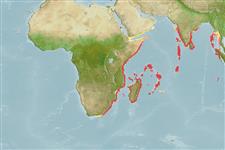Environment: milieu / climate zone / depth range / distribution range
Sinh thái học
Biển Cùng sống ở rạn san hô; Mức độ sâu 10 - 150 m (Ref. 9710). Tropical; 19°N - 36°S, 23°E - 98°E (Ref. 5222)
Indian Ocean: Gulf of Aden south to Port Alfred, South Africa and east to the northwest tip of Sumatra, Indonesia. Also found in the islands of western Indian Ocean, including Cargados Carajos and Rodriguez. Not known from the Red Sea and Persian Gulf.
Length at first maturity / Bộ gần gũi / Khối lượng (Trọng lượng) / Age
Maturity: Lm ?, range 49 - ? cm
Max length : 90.0 cm TL con đực/không giới tính; (Ref. 4319); common length : 45.0 cm TL con đực/không giới tính; (Ref. 5450); Khối lượng cực đại được công bố: 15.0 kg (Ref. 4319)
Các tia vây lưng cứng (tổng cộng) : 11; Các vây lưng mềm (tổng cộng) : 16 - 17; Tia cứng vây hậu môn: 3; Tia mềm vây hậu môn: 8. Adults have yellow fins. Small juveniles about half blue, half yellow (Ref. 48635); distinguished by having sky blue color of head and body in juveniles to dark bluish violet or dark greyish blue in adults; yellow upper lip; ctenoid scales on body except cycloid scales anterodorsally above lateral line and on thorax and abdomen; body of adult with numerous auxiliary scales; moderately deep bodied, greatest depth 2.4-2.8 in SL; truncate to slightly emarginate caudal fin; pelvic fins 1.7-2.0 in head length (Ref. 90102); further characterized by having head length 2.4-2.7 times in SL; preorbital depth 6.8-8.8 times in head length for fish 36-66 cm SL; interorbital area convex; adults posterior nostrils 4-5 times larger than anterior nostrils; subangular preopercle, serrae at angle enlarged; straight to slightly convex upper edge of operculum; maxilla reaches to or slightly past vertical at rear edge of eye; 2-4 rows of teeth on midlateral part of lower jaw (Ref. 89707).
Juveniles inhabit shallow reefs while adults are found on deeper reefs. Feeds on a variety of fishes, crabs, shrimps, spiny lobsters, squids, and small octopi. Solitary (Ref 90102).
Life cycle and mating behavior
Maturities | Sự tái sinh sản | Spawnings | Egg(s) | Fecundities | Ấu trùng
Heemstra, P.C. and J.E. Randall, 1993. FAO Species Catalogue. Vol. 16. Groupers of the world (family Serranidae, subfamily Epinephelinae). An annotated and illustrated catalogue of the grouper, rockcod, hind, coral grouper and lyretail species known to date. Rome: FAO. FAO Fish. Synop. 125(16):382 p. (Ref. 5222)
IUCN Red List Status (Ref. 130435)
Threat to humans
Harmless
Human uses
Các nghề cá: Tính thương mại; Bể nuôi cá: Tính thương mại
Các công cụ
Special reports
Download XML
Các nguồn internet
Estimates based on models
Preferred temperature (Ref.
123201): 23.3 - 28.1, mean 26.1 °C (based on 78 cells).
Phylogenetic diversity index (Ref.
82804): PD
50 = 0.5000 [Uniqueness, from 0.5 = low to 2.0 = high].
Bayesian length-weight: a=0.01175 (0.00571 - 0.02419), b=3.04 (2.88 - 3.20), in cm total length, based on LWR estimates for this Genus-body shape (Ref.
93245).
Mức dinh dưỡng (Ref.
69278): 4.2 ±0.55 se; based on food items.
Thích nghi nhanh (Ref.
120179): thấp, thời gian nhân đôi của chủng quần tối thiểu là 4.5 - 14 năm (Preliminary K or Fecundity.).
Fishing Vulnerability (Ref.
59153): High vulnerability (56 of 100).
Nutrients (Ref.
124155): Calcium = 17.7 [8.3, 38.2] mg/100g; Iron = 0.409 [0.217, 0.822] mg/100g; Protein = 18.6 [17.1, 20.0] %; Omega3 = 0.124 [0.078, 0.201] g/100g; Selenium = 47 [27, 84] μg/100g; VitaminA = 149 [42, 537] μg/100g; Zinc = 1.05 [0.74, 1.47] mg/100g (wet weight);
